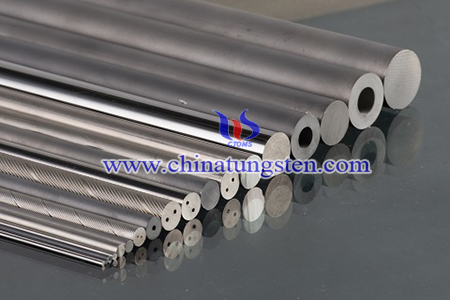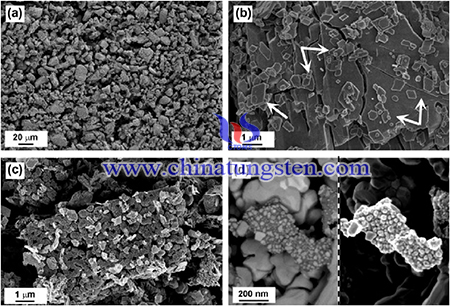W/TaC Composites as Plasma-Facing Materials Using Ammonium Paratungstate
- Details
- Category: Tungsten Information
- Published on Thursday, 08 July 2021 01:08
The development of high-performance plasma-facing materials (PFMs) is one of the key issues in realizing the safe application of nuclear fusion reactors. The extreme working environment of PFMs in fusion devices is primarily characterized by high thermal load, high-energy particle bombardment, and high flux hydrogen (H)/helium (He) plasma irradiation. Tungsten and its alloys are promising plasma-facing materials (PFM) that were used for the international thermonuclear experimental (ITER) divertor and have been regarded as the most promising plasma materials for future fusion reactors.
The body-centered cubic crystal structure of tungsten has almost no ductility. As such, this metal cannot be used for structural applications at temperatures lower than DBTT. At elevated temperatures, low recrystallization is another factor that decreases the strength and creep resistance of tungsten and its alloys at high temperatures.Tantalum carbide (TaC) nanoparticles doped in tungsten powders could largely enhance the physical properties of tungsten. Thus, W/TaC composites has been successfully prepared using ammonium paratungstate as plasma-facing materials, the thermal conductivity of the as-prepared composites have been greatly improved.

The preparation method of is as following steps: The TaC contents of the doped W precursor (W–1.0 wt.% TaC, W–2.0 wt.% TaC, and W–4.0 wt.% TaC) were determined by stoichiometry. The precursors were synthesized from ammonium paratungstate (APT) and TaC particles with a particle size of approximately 50 nm. A small amount of TaC nanoparticles were doped in an aqueous solution of oxalic acid, and a suspension solution was obtained via ultrasound-assisted dispersion. The ultrasonic equipment was turned off after the APT powder was dissolved in the suspension solution and the TaC nanoparticles were uniformly dispersed in the solution. Table 1 shows the different TaC contents that were added in W. The mixture was then evaporated at 170 °C. The mixture was allowed to react in an oil bath-assisted methyl silicone with magnetic stirring for a specific time period. The obtained precursor was ground using an agate mortar. The precursor was then reduced in a tubular furnace by high-purity H2 at a heating rate of 5 °C/min and at temperatures of 200, 500, and 800 °C with holding times of 30, 60, and 60 min, respectively. Under the same heating rate, the powders were cooled down to 500 °C and eventually to room temperature. H2 was allowed to continuously flow throughout the reduction process.

Different TaC contents of W/TaC composite powders were sintered via SPS. The obtained powder was first placed into a graphite mold, and a uniaxial pressure was then loaded from 9.6 MPa to 15.9 MPa. The sample was heated to 450 °C by using a pulse current. The sample was then heated to 700 °C at a heating rate of about 100 °C/min and a holding time of 2 min to mitigate the rapid increase in pressure. This sintering process was carried out at vacuum conditions. Simultaneously, the pressure was slowly increased from 15.9 MPa to 57.3 MPa, which was then kept constant throughout the sintering processes. A protective atmosphere, which is composed of Ar and 3 vol.% H2, was used for the following sintering processes to prevent the oxidation of the sample. The samples were heated at 1350 °C at a heating rate of about 100 °C/min and a holding time of 5 min. The samples were subsequently heated at 1750 °C at the same heating rate and then at 1800 °C at a heating rate of about 50 °C/min. The samples were cooled down to room temperature at a cooling rate of about 100 °C/min after holding for 1 min at 1800 °C. The obtained sintered samples were compressed in a disk component with a diameter of about 20 mm and a thickness of 2 mm.
In conclusion, W/TaC composites has been successfully prepared using ammonium paratungstate as plasma-facing materials, the thermal conductivity of the as-prepared composites have been greatly improved. The obtained pure W bulk material exhibited a relative density of 97.21%. This parameter decreased with the increase in TaC content. The microhardness values of W were enhanced from approximately 301.05 Hv to 524.71 Hv by doping different contents of TaC. The thermal conductivity of W–1 wt.% TaC at room temperature was 183.8 W/mK, which is greater than the thermal conductivity of pure W (i.e., 148.3 W/mK).
- APT Manufacturer & Supplier, Chinatungsten Online: ammonium-paratungstate.com
- Tungsten News & Prices of China Tungsten Industry Association: www.ctia.com.cn
- Molybdenum News & Price: news.molybdenum.com.cn
- Tel.: 86 592 5129696; Fax: 86 592 5129797; Email: sales@chinatungsten.com



 sales@chinatungsten.com
sales@chinatungsten.com